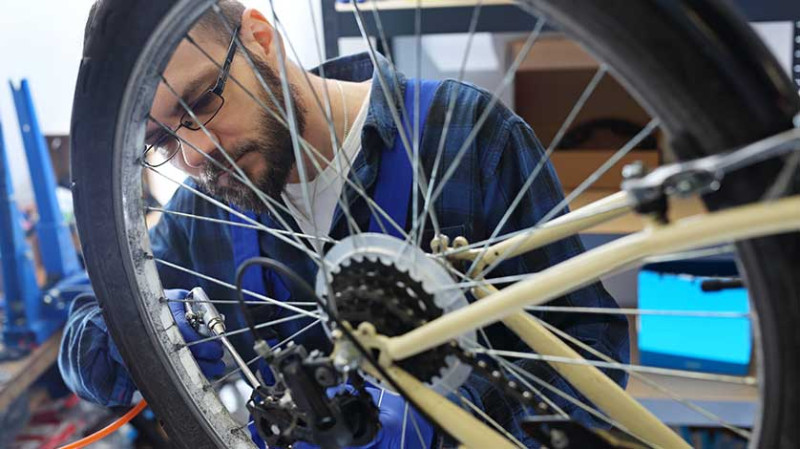
Investing the time and effort to learn how to service your bicycle is one of the smartest moves a cyclist, whether beginner or seasoned, can make. Not only can regular maintenance save money in the long term, but it can also improve your bike's performance and lifespan. For DIY enthusiasts, young professionals passionate about self-improvement, and even architects and designers seeking creative weekend projects, tackling your bicycle service is both a practical and satisfying skill.
With the right tools, a bit of time and a touch of patience, you can keep your ride smooth and safe. Whether you're commuting daily through the streets of Manchester or enjoying weekend trail rides in the Lake District, knowing how to service your bicycle puts you in control and strengthens your connection to your machine.
This guide outlines everything you need to know to get started, from essential tools and workspace setup to key maintenance tasks and troubleshooting tips. Whether you're gearing up for spring or just want a smoother daily ride, this DIY approach will have your bike running like a dream.
Why Servicing Your Bicycle Matters
Like regular visits to the GP keep you in good health, scheduled maintenance ensures your bike is running at optimal performance. Letting issues go unchecked can lead to costly damage or, worse, dangerous riding conditions. A poorly maintained drivetrain can wear out prematurely, brakes may lose efficiency, and loose components can compromise your control.
Bicycles are often an overlooked part of household maintenance, especially for busy professionals and tradespeople who rely on them for transport or fitness. The good news is that basic service tasks don't require a degree in mechanical engineering. With a few tools and a little practice, anyone can confidently handle standard maintenance.
For homeowners looking to add another skill to their DIY toolkit and perhaps even design their own tidy bike maintenance corner in the garage or shed, this is a perfect project to take up. Plus, there's something incredibly satisfying about understanding every nut and bolt on your ride.
Consistent servicing also keeps your warranty valid and improves resale value. If you're upgrading to a new bike model or need to sell your current one, a well-documented maintenance history makes your listing far more attractive.
Setting Up the Right Workspace
Before diving into the nuts and bolts, it's crucial to create a comfortable and efficient workspace. This could be a designated corner in your garage, a shed or even a balcony with good lighting and weather protection. Make sure the space is clean, dry and has adequate storage for tools and parts.
A workstand is an investment that pays off immediately. It elevates the bike to a comfortable height and provides stability, allowing you to rotate pedals, free the wheels and access components with ease. Wall hooks or vertical racks are a brilliant way to store your bike when not in use, especially in smaller homes or flats across urban areas.
A sturdy toolbox or pegboard is ideal for organising your tools, especially if you're the kind who already enjoys working on the home or car. Consider labeling drawers for quick reference and keeping a notepad nearby for jotting down part replacements or maintenance dates.
For those who are visual learners, mounting a tablet or screen to play instructional videos as you work is a great way to multitask. You'll be surprised at how quickly you'll grasp concepts when applying them in real time.
Essential Tools for DIY Bicycle Maintenance
Just like a good chef needs a reliable set of knives, a DIY bicycle mechanic needs the right tools. Most bike-related issues can be resolved with a core set of equipment. Here's a starter list to keep handy in your cycling workshop:
| Tool | Purpose |
|---|---|
| Allen Key Set (Hex Keys) | For adjusting most bolts on the bike, including stem, seat post and brake levers. |
| Tire Levers | Crucial for removing tires from the rim without damaging them. |
| Track Pump with Pressure Gauge | Ensures your tyres are inflated to correct PSI for optimal performance and comfort. |
| Chain Breaker Tool | Used to replace or shorten a bicycle chain safely. |
| Lubricant and Degreaser | Keeps your chain and drivetrain running smoothly and cleanly. |
| Torque Wrench | Helps avoid overtightening bolts, especially useful for carbon components. |
| Screwdrivers | Useful for adjusting brakes, derailleurs and other small components. |
| Brushes and Rags | Indispensable for cleaning components and keeping your workspace tidy. |
For more advanced servicing needs, additional tools like a bottom bracket tool, cone spanners or a cassette remover may be necessary, especially if you=E2=80=99re planning to do full overhauls of the drivetrain or wheel hubs.
Routine Maintenance Tasks You Can Do Yourself
Most bike maintenance can be broken down into regular intervals: before every ride, weekly, monthly and seasonally. Doing small things often can prevent big problems later. Here are the fundamental tasks to start doing regularly:
Cleaning the Frame and Drivetrain: After muddy rides or wet commutes, give your bike a thorough rinse and gently scrub the frame. Use a degreaser for the chain, cassette and derailleur pulleys. Once cleaned, dry everything before applying new lubricant to the chain.
Checking Tyres and Inflating: Proper tyre pressure not only improves performance but also helps prevent punctures and rim damage. Check the sidewall for the recommended PSI range and inspect tires for embedded glass or sharp objects.
Brake Pad Inspection: Look for wear indicators on your brake pads. If the grooves are gone or the pad is worn unevenly, it's time for a replacement. Also check cable tension and brake lever response.
Gear Tuning: Over time, derailleur cables stretch, making your bike shift sluggishly. Minor adjustments to the barrel adjuster can often fix indexing issues. If that doesn=E2=80=99t help, consider checking your derailleur hanger alignment or replacing the cable itself.
Lubricating the Chain: One of the easiest and most important tasks. A clean and well-lubricated chain drastically improves efficiency and reduces component wear. Avoid over-lubrication, as it attracts more dirt=E2=80=94wipe away excess oil after application.
How Often Should You Service Your Bike?
The frequency of your maintenance depends on how often and where you ride. In general, everyday commuters or wet-weather cyclists should clean and check their bike more regularly. Here's a simple guideline:
- Weekly: Clean the drivetrain, inspect tyres, top up tyre pressure
- Monthly: Check and adjust brakes, clean frame, tighten bolts
- Quarterly: Inspect and replace cables, check for frame cracks, lube bottom bracket area
- Bi-annually: Full drivetrain clean, chain replacement if worn, wheel truing
Using a maintenance log=E2=80=94either digital or on paper=E2=80=94can make this easier to manage. Record dates, part replacements and any upgrades made to keep your servicing history organized and efficient.
Common Issues and How to Fix Them
Even with regular upkeep, bikes can develop issues. Learning to troubleshoot common problems is empowering and can often save you a ride to the bike shop.
Chain Slipping: Most likely caused by a worn chain, cassette or both. Measure chain wear with a chain checker and replace components as needed.
Squeaky Brakes: Often due to dirty pads or rims. Sand down the pad surfaces gently and clean the wheel with rubbing alcohol. Also, recheck toe-in alignment.
Skipped Shifts: This can be due to an incorrectly adjusted derailleur. Try adjusting the barrel adjuster on your shifter or rear derailleur before jumping to conclusions.
Noisy Pedals or Bottom Bracket: Could be from dirt ingress or looseness. Remove, clean, re-grease and re-tighten the pedals. If the problem persists, consider servicing your bottom bracket.
Punctures: Make sure to inspect the tyre and tube carefully before replacing. Always check for thorns or debris lodged in the casing's common to puncture again straight after a tube change if not careful.
When to Call in the Professionals
While many maintenance tasks can be handled at home, there are times when professional help is wisest. Wheel truing, hydraulic brake bleeding or suspension servicing may require expert knowledge and dedicated tools. If you're unsure, it's better (and safer) to take your bike to a certified mechanic.
Furthermore, many UK bike shops offer educational workshops or one-on-one tutorials. These are a great way for DIYers to fill knowledge gaps and become more confident without needing to commit to a full-service visit.
Conclusion: Take the Wheel (Literally)
Whether you're a weekend rider, an eco-conscious urban commuter, or a hands-on homeowner who takes pride in DIY capability, knowing how to service your bicycle is an invaluable skill. It's affordable, enjoyable, empowers independence and opens the door to better cycling experiences.
Like any home improvement project, the journey starts with a few simple tasks. Before long, you'll be swapping chains, adjusting gears and speaking the language of bike tech with ease. From the cobbled paths of Edinburgh to the rolling hills of Devon, your ride will be smoother, safer and more responsive to your needs, because you've put in the time to know it inside and out.
So roll up those sleeves, hang that bike on the workstand, and start spinning your way to a more empowered cycling lifestyle.





